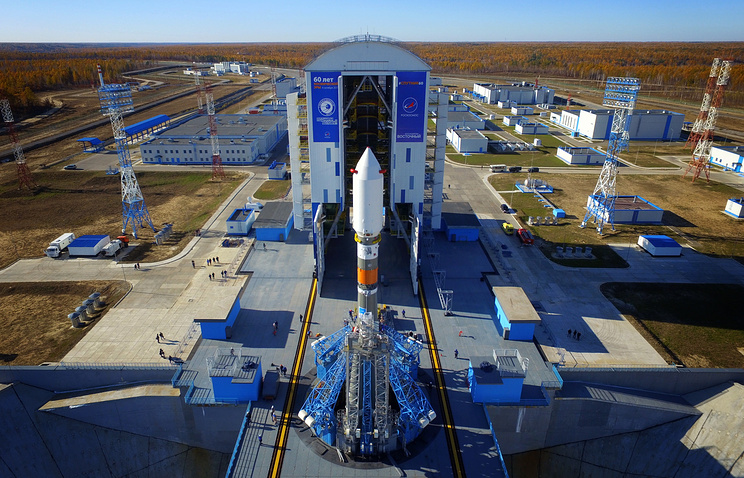Roscosmos specialists programmed the launch of the fallen "Union" from Baikonur, and not the Eastern

Soyuz-2 launch vehicle with the Fregat upper stage during testing of the launch complex at the Vostochny cosmodrome. Source: Yuri Smithyuk / TASS
Yesterday it became known about the results of a preliminary analysis of the telemetric information of the Soyuz-2.1b rocket emergency launch. According to the Interfax source, the cause of the loss of the Meteor-M satellite is the wrong maneuver of the upper stage. As far as one can understand, the maneuver would be correct when launching from other cosmodromes, since the upper stage was programmed to start from Baikonur, and not from the East.
“The“ Fregat ”overclocking unit performed the first maneuver to reach the orbit in the wrong orientation. As a result, the maneuver was not accelerating, but braking - and instead of entering a transitional orbit, the accelerating unit went along with the payload towards the Earth and sank in the Atlantic Ocean, ”said a source close to the commission investigating the problem.
The main error was contained in the flight task, as a result of which the Frigate performed a maneuver in a non-optimal direction. As a result, the accelerating unit did not have time to finish this maneuver before the propulsion system was turned on. The state commission is now investigating the stage at which the mistake was made. It could be admitted at the stage of issuing the initial data or at the stage of drawing up the flight task.
Both the Soyuz-2.1b rocket and the Fregat upper stage are equipped with various control systems. In this case, the flight task for the upper stage was calculated for launch from Baikonur. It is worth noting that the maneuver was somewhat unexpected for the team of specialists that managed the flight. This team included people who were not involved in the preparation of launch systems, so they could not understand what was the true reason for the strange behavior of the upper stage.
“The wrong orientation during the maneuver occurred due to an error in the flight task for the control system of the upper stage. As a result, before the maneuver, the “Frigate” began to turn in a non-optimal direction and did not have time to finish it before turning on the propulsion system, ”the Interfax source said.
In the Soyuz-Frigate system, the first three launch stages of the rocket and the upper stage have two separate guidance systems with their own gyroscopic platforms. The difference between the guidance of the Soyuz and Frigate gyroscopes is 10 degrees. The geographical azimuth of the Soyuz / Fregat system for Bainkonur, Plesetsk, and Kourou was usually in the range of plus 140 to minus 140 degrees. In order for the gyroscopic control system to be brought to operational readiness, its main platform had to be turned to the zero position along the shortest path. But the azimuth of the East is 174 degrees, plus another 10 degrees for the Frigate. This means that his maneuver had to make a turn of 184 degrees to reach zero position.
As for the Soyuz gyro-platform, the maneuver was executed correctly, the system made a turn from 174 degrees to the zero position. But the computer unit "Frigate" gave the command to make a more complex maneuver. Instead of increasing the angle from 184 degrees to 360, the computer commanded a reverse turn. Initially, the platform was in the required position, but then the computing unit "decided" that the current position was different from the required 360 degrees. As a result, the maneuver began to be performed, which, after turning to 60 degrees, stopped - the gyroscopes failed. As a result, the Frigate lost its ability to navigate in space and everything went wrong.
The launch vehicle Soyuz-2.1b was launched on November 28 from the Vostochny cosmodrome. This rocket was supposed to launch the Earth remote sensing satellite (RSE) Meteor-M No. 2-1 and another 18 small spacecraft of an associated load into low near-earth orbit. Satellite Meteor-M was supposed to separate at 09:32 on November 28, after which telemetry transmission was expected. But she was not received. Now the exact location of "Meteora-M" is unknown. According to some data, it can be in an unplanned orbit, on the other - it fell into the Atlantic Ocean.
Find out what happened in reality, should emergency commission. Her work is scheduled until December 15, 2017, the next meeting will be held on December 1, 2017.
Well, today the Soyuz-2.1b launch vehicle successfully launched a military satellite into orbit, RIA Novosti reports . True, the launch was carried out not from the Vostochny cosmodrome but from Plesetsk.
All Articles